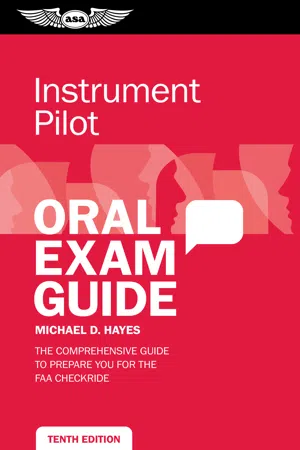![]()
1
Preflight
A. Pilot Qualifications
1. An applicant for an instrument rating must have at least how much and what type of flight time as pilot? (14 CFR 61.65)
A person who applies for an instrument–airplane rating must have logged the following:
a. 50 hours of cross-country flight time as PIC, of which 10 hours must have been in an airplane;
b. 40 hours of actual or simulated instrument time in the Part 61 areas of operation, of which 15 hours must have been received from an authorized instructor who holds an instrument airplane rating, and the instrument time includes:
• 3 hours of instrument flight training from an authorized instructor in an airplane that is appropriate to the instrument–airplane rating within 2 calendar months before the date of the practical test;
• Instrument flight training on cross country flight procedures, including one cross country flight in an airplane with an authorized instructor, that is performed under IFR, when a flight plan has been filed with an ATC facility, and that involves a flight of 250 NM along airways or ATC-directed routing, an instrument approach at each airport, and 3 different kinds of approaches with the use of navigation systems.
Exam Tip: The evaluator may ask you to demonstrate that you’re current and eligible to take the practical test. When preparing for your practical test, verify that you have the required hours, that you’re current, and don’t forget to double-check all of your endorsements. Make sure you have totaled all of the logbook columns and that the entries make sense.
2. When is an instrument rating required? (14 CFR 61.3, 61.133, 91.135, 91.157)
When operations are conducted:
a. Under instrument flight rules (IFR flight plan),
b. In weather conditions less than the minimum for VFR flight,
c. In Class A airspace,
d. Under Special VFR within Class B, Class C, Class D and Class E surface areas between sunset and sunrise.
e. When carrying passengers for hire on cross-country flights in excess of 50 nautical miles or at night.
3. What are the recency-of-experience requirements to be PIC of a flight under IFR? (14 CFR 61.57)
The recency-of-experience requirements are:
a. A flight review;
b. To carry passengers, 3 takeoffs and landings within the preceding 90 days in an aircraft of the same category, class and type, if a type rating is required (landings must be full stop at night or in a tailwheel).
c. Within the 6 calendar months preceding the month of the flight, performed and logged in actual weather conditions or under simulated conditions using a view-limiting device, at least the following tasks in an airplane:
• Six instrument approaches.
• Holding procedures and tasks.
• Intercepting and tracking courses through the use of navigational electronic systems.
Note: 14 CFR §61.57(c) allows the use of an aircraft and/or a full flight simulator, flight training device, or aviation training device for maintaining instrument experience, subject to certain limitations.
Remember: 6-6-HIT. 6 approaches in previous 6 months including Holding, Intercepting and Tracking courses.
4. Must a flight instructor be present if you are planning on using an aviation training device to maintain your IFR currency? (14 CFR 61.51, 61.57)
No. A pilot may accomplish the recency of experience requirements in a full flight simulator, flight training device, or aviation training device, provided the device represents the category of aircraft for the instrument rating privileges to be maintained and the pilot performs the tasks and iterations in simulated instrument conditions. A logbook or training record must specify the training device, time, and the content. An instructor is not required to be present.
5. Are you required to have an instructor present when a using time in an FFS, FTD, or ATD to acquire instrument aeronautical experience for a pilot certificate or rating? (14 CFR 61.51)
Yes, an instructor must be present. A person may use time in a full flight simulator, flight training device, or aviation training device for acquiring instrument aeronautical experience for a pilot certificate or rating, provided an authorized instructor is present to observe that time and signs the person’s logbook or training record to verify the time and the content of the training session.
6. If a pilot allows his/her instrument currency to expire, what can be done to become current again? (14 CFR 61.57, 91.109)
A pilot is current for the first 6 months following his/her instrument checkride or proficiency check. If the pilot has not accomplished at least 6 approaches (including holding procedures, intercepting/tracking courses through the use of navigation systems) within this first 6 months, he/she is no longer legal to file and fly under IFR. To become legal again, the regulations allow a “grace period” (the second 6-month period), in which a pilot may get current by finding an “appropriately rated” safety pilot, and in simulated IFR conditions only, acquire the 6 approaches, etc. If the second 6-month period also passes without accomplishing the minimum, a pilot may reinstate his/her currency by accomplishing an instrument proficiency check given by an examiner, an authorized instructor, or an FAA-approved person to conduct instrument practical tests.
7. Explain the difference between being “current” and being “proficient.” (FAA-H-8083-2, FAA-P-8740-36)
Being “current” means that a pilot has accomplished the minimum FAA regulatory requirements within a specific time period so he or she can exercise the privileges of the certificate. It means that you’re “legal” to make a flight, but does not necessarily mean that you’re proficien...
